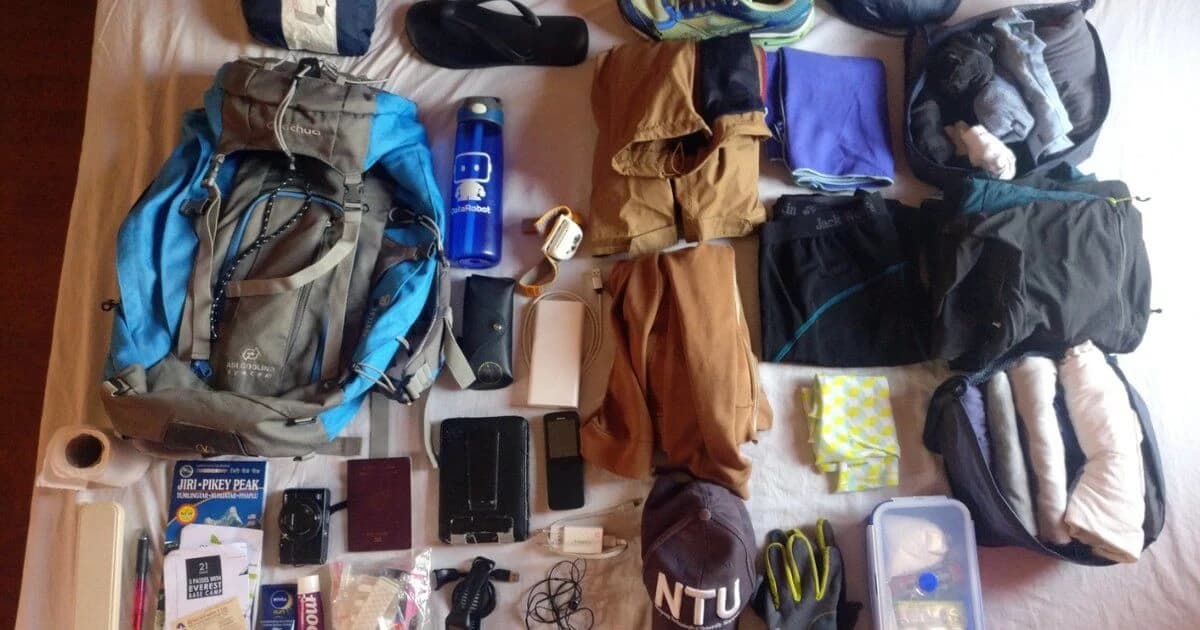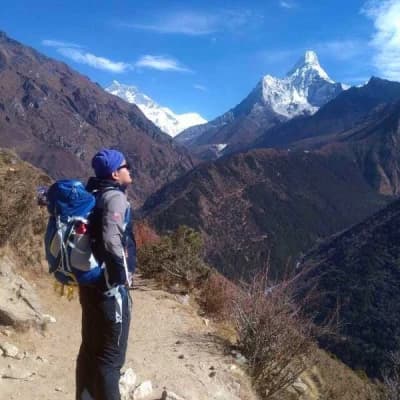Trekking in Nepal—whether you're heading to Everest Base Camp, hiking the Annapurna Circuit, or exploring remote, off-the-beaten-path trails—is an adventure like no other. But here’s the catch: your trek can be the adventure of a lifetime or a tough, uncomfortable ordeal depending on the gear you pack.
Trust us, choosing the right equipment makes all the difference! Let’s break it down for you in a fun, easy-to-understand way.
Why the Right Gear Makes All the Difference?
Imagine this: you’re trekking along a stunning trail, but suddenly, the weather turns. A snowstorm hits or the sun starts blazing—your gear can make or break how comfortable you feel. The right equipment ensures that you’re prepared for whatever Nepal throws your way, so you can focus on the breathtaking views and unforgettable experiences.
Here’s why gear matters:
- Stay comfortable, no matter the weather: Nepal’s climate can change at the drop of a hat—from chilly mornings to scorching afternoons. The right gear keeps you comfortable all day.
- Weatherproof your adventure: From sudden rain to gusty winds, the right gear has you covered.
- Carry only what you need: Overpacking? Nope! Smart packing keeps your bag light and your trek hassle-free.
- Safety first: Having the right equipment keeps you safe in case of unexpected situations—because safety’s always the priority.
Now, let's dive into the essential gear you'll need for your trekking adventure!
Clothing: Layer Up Like a Pro
In Nepal, the weather can be unpredictable, so layering is the way to go! Think of it like building the perfect outfit for a day out—except you’re ready for rain, snow, sun, or freezing temperatures, all in one trek!
Here’s the clothing breakdown:
- Base Layer: Moisture-wicking thermal tops and bottoms—these keep sweat off your skin and help you stay warm and dry. Avoid cotton at all costs—it holds moisture and takes forever to dry.
- Mid Layer: A fleece or lightweight down jacket is your go-to for insulation. Trust us, this will keep you warm without the bulky feel!
- Outer Layer: A waterproof, windproof jacket is a MUST. You never know when you’ll face rain or snow on the trail, and this layer will protect you from the elements.
Pro Tips for Additional Clothing:
- Gloves: Inner gloves for warmth, and outer waterproof gloves for extra protection.
- Buff or Scarf: It keeps the dust, wind, and cold off your face!
- Hat: A beanie to stay warm and a sun hat for those sunny moments.
- Sunglasses: Protect your eyes from the harsh sun (and that snow glare!) at higher altitudes.
|
Clothing Item |
Quantity |
|
Base Layer Tops |
2-3 |
|
Base Layer Bottoms |
1-2 |
|
Insulated Jacket |
1 |
|
Fleece Jacket |
1 |
|
Trekking Shirts |
2-3 |
|
Trekking Pants |
2 |
|
Waterproof Jacket |
1 |
|
Waterproof Pants |
1 |
|
Insulated Pants/Tights |
1 |
|
Trekking Socks |
3-4 pairs |
|
Underwear |
4-5 pairs |
|
Gloves |
1 |
|
Hat/Beanie |
1 |
|
Sun Hat/Cap |
1 |
|
Buff/Neck Gaiter |
1 |
|
Sleepwear |
1 set |
Footwear: Your Feet Are Your Lifeline
Trekking in Nepal is tough on your feet, so don’t skimp on your footwear! If your feet aren’t happy, your whole trek can go downhill fast.
- Trekking Boots: Waterproof, ankle-supportive, and well broken-in before your trek—nothing worse than blisters in the mountains!
- Camp Shoes or Sandals: After a long day, you’ll want something comfy for your feet when you reach the campsite.
- Woolen Socks: Wool keeps your feet warm and helps prevent blisters, even if your socks get a little damp.
- Gaiters: These nifty accessories protect your boots from mud, snow, and debris.
Backpacks & Carrying Gear: Pack Smart, Trek Smart
Your pack will be your best friend (or worst enemy) on your trek. Choose wisely!
- Main Backpack (50L-65L): It should fit well, be comfortable, and have padded straps. A breathable back panel is a plus!
- Daypack (20L-30L): Carry your essentials like snacks, water, and a jacket. Perfect for shorter hikes or day trips from the base camp.
- Duffel Bag: If you’re using a porter, this is a great way to store your stuff.
- Dry Bags: Keep your electronics and clothes dry, even if the weather takes a turn for the worse.
Recommended Read: Hiking vs Trekking
Sleeping Gear: Sweet Dreams in the Mountains
Teahouses provide basic blankets, but we always recommend bringing your own sleeping gear for extra warmth and comfort.
- Sleeping Bag (-10°C to -20°C rating): For high-altitude treks, this is essential. Trust us, those mountain nights get cold!
- Sleeping Bag Liner: Adds an extra layer of warmth and keeps things fresh.
Trekking Accessories & Tools: Because You Never Know When You’ll Need Them
Having a few handy accessories can make a big difference on the trail:
- Trekking Poles: These help with balance and reduce knee strain, especially on tough uphill sections.
- Headlamp with Extra Batteries: You’ll want to be ready if you’re trekking in the evening or early morning.
- Multitool Knife: For all those "just-in-case" moments.
- Duct Tape: Believe us, duct tape has saved many trekkers from gear malfunctions!
Hydration & Nutrition: Keep Energized & Hydrated
To keep going strong, it’s crucial to stay hydrated and fueled up. You’ll need energy to conquer those long days of trekking!
- Water Bottle or Hydration Bladder (2-3L): Hydration prevents altitude sickness. A hydration bladder makes drinking while walking a breeze.
- Water Purification Tablets or Filter: Say goodbye to plastic bottles and hello to purified water!
- Energy Bars, Nuts, and Chocolates: These are your go-to snack to keep you fueled and energized during those long climbs.
Personal Hygiene & First Aid: Stay Clean & Ready
Personal hygiene might be tough on the trail, but it’s still important to have the essentials and be prepared for anything.
- Toiletries: Travel-sized toothpaste, toothbrush, biodegradable soap, and wet wipes.
- Toilet Paper & Ziplock Bags: Be prepared to pack out what you bring in—Nepal's remote areas don’t have trash facilities.
- First Aid Kit: Bandages, painkillers, altitude sickness tablets, and blister treatment are a must!
Electronics & Gadgets: Stay Connected & Capture the Beauty
There’s no better place to capture memories than in Nepal, but you’ll need some gadgets to help!
- Power Bank (10,000mAh-20,000mAh): Teahouses charge for devices, so bring your own backup power.
- Universal Adapter: Nepal uses Type C, D, and M plugs, so make sure you're ready to charge.
- Camera or Smartphone: Capture those epic mountain views and unforgettable moments.
- Notebook & Pen: Keep track of your experiences on paper—you'll want to remember it all!
Pro Tips for Packing Smart
- Pack Light: Don’t bring more than you need. Every extra gram counts!
- Master Layering: Layering is more efficient than bulky clothing. You can always add or remove layers as needed.
- Break in Your Gear: Don’t wait until you're on the trail to test your boots. Make sure everything’s comfortable.
- Rent Gear in Nepal: Kathmandu has tons of shops where you can rent trekking gear if you're missing something.
Get Ready to Trek Like a Pro!
Packing for your trek doesn’t have to feel overwhelming! With the right gear, you’ll be ready to take on the mountains of Nepal in comfort and safety. So, what are you waiting for? Get your gear ready, and let’s make those trekking dreams come true!
For expert guidance and customized trekking packages, check out Tidy Himalaya—your ultimate trekking partner. Happy trekking!
FAQs:
Is trekking in Nepal suitable for beginners?
Trekking in Nepal can be suitable for beginners, especially on more accessible routes like Ghorepani Poon Hill or Langtang Valley. Being in good physical condition is essential, considering guided tours for safety, and acclimatizing appropriately to higher altitudes is essential.
What is the best time of year to trek in Nepal?
Trekking seasons in Nepal generally coincide with spring (March to May) and autumn (September to November). These periods offer stable weather, clear skies, and moderate temperatures, making them ideal for trekking.
Where can I buy the right trekking gear in Nepal?
You can find trekking gear in Nepal at various places, such as Thamel in Kathmandu, local stores and markets in major cities like Pokhara, specialized outdoor gear shops, rental shops, and even online platforms offered by local stores.
What gear do I need for trekking in Nepal?
You must pack sturdy hiking boots together with layers of clothing and advantages the durability of a backpack along with waterproof outerwear at the same time as trekking poles for stability and a suitable sleeping bag for the climate. Hikers must carry navigation tools including map and compass or GPS together with a first aid kit as well as personal hygiene products.
Can I hire a guide or porter for my trek?
Yes, you can hire experienced guides or porters for your trek in Nepal. Hiring a guide is highly recommended for navigating trails, understanding the local culture, and ensuring safety. Porters can help carry your gear, making your trek more comfortable.
Are there altitude-related risks during trekking in Nepal?
Yes, trekking in Nepal involves altitude changes, posing risks such as acute mountain sickness (AMS) or altitude sickness. Symptoms of AMS may include headache, nausea, dizziness, and fatigue. Acclimatizing properly is essential by ascending gradually, staying hydrated, and listening to your body.


.webp&w=1200&q=75&dpl=dpl_2PwU5ZDv8uoJ3KrzEVbz8N547HgX)
.webp&w=1200&q=75&dpl=dpl_2PwU5ZDv8uoJ3KrzEVbz8N547HgX)
.webp&w=1200&q=75&dpl=dpl_2PwU5ZDv8uoJ3KrzEVbz8N547HgX)